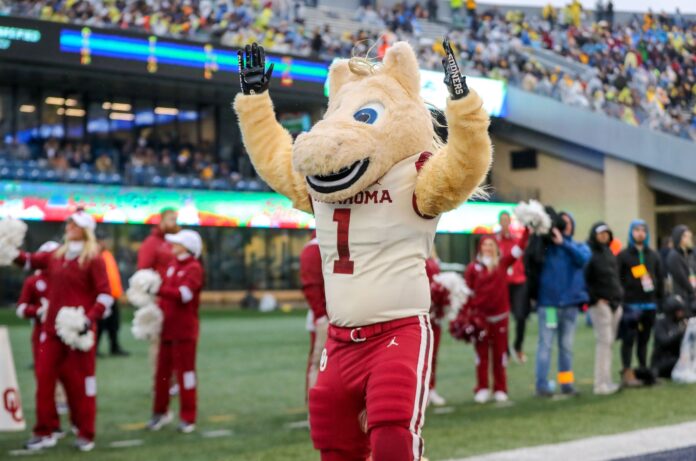College football mascots are meant to epitomize the pageantry of the nation’s greatest sport. Few manage to capture that theatre while maintaining a cultural link to the program they represent than the Oklahoma Sooners mascot.
Who (or What) Is the Oklahoma Sooners Mascot?
Although they boast a pair of costumed mascots, the Sooner Schooner is the official mascot of sports teams at Oklahoma University. Pulled by the white horse combination of Boomer and Sooner, the tradition of running the schooner around a horseshoe loop of Owen Field has become one of college football’s most recognizable traditions.
However, the Sooners mascot also maintains links to the local heritage. The Sooner Schooner is a smaller-scale version of the original Conestoga wagon that formed the mobile home for many of the in-state settlers in the late 1800s.
The Sooners mascot was first used in 1964, officially becoming the Oklahoma mascot in 1980. The Sooner Schooner is always pulled by two white horses known as Boomer and Sooner — another historical cultural reference. Since their introduction in 1964, there have been five different Boomer and Sooner pairings, with the latest being in use since the 2008 season.
MORE: PFN’s FREE NFL Mock Draft Simulator With Trades
The Sooner Schooner is driven by a member of the RUF/NEKS — an organization dating back to the 1920s — with the RUF/NEK Queen alongside the driver and a younger member of the organization teetering precariously from the rear of the vehicle waving the university flag.
If the latter doesn’t sound dangerous enough, the Sooner Schooner has been involved in various incidents and controversies during its tenure as the Sooners mascot. There have been several overturns caused by turning too sharply. Meanwhile, a premature drive onto the field in the 1985 Orange Bowl resulted in the vehicle becoming stuck in the turf.
As college football mascots become more involved in non-sideline activities such as community appearances, Oklahoma introduced a costumed version of Boomer and Sooner in 2005.
Why Is Oklahoma Called the Sooners?
Previously nicknamed the Rough Riders or Boomers, the sports teams at Oklahoma University have been known as the Sooners since 1908. Some college football teams have catchy nicknames referencing local wildlife or animals that reflect the characteristics of the program, but Oklahoma’s nickname is rooted in a complex heritage that the university takes pride in.
The Sooners nickname comes from the late 1800s and was originally applied to groups of people that attempted to settle in what was known as the “Unassigned Lands” — a by-product of the forcible relocation of several tribal nations following the Civil War.
In the late 1800s, Oklahoma was made up of two territories — or Twin Territories — that consisted of Oklahoma Territory and Indian Territory. The “Unassigned Lands” were incorporated into Oklahoma Territory, but not before races were held to settle in the area.
Like modern-day athletic events, the races were started with a pistol shot, and any prospective settlers that attempted to gain a false start advantage were known as Sooners. According to the Oklahoma website, the “Sooner” name “came to denote energetic, can-do individuals,” with the nickname combining cultural and characteristic relevance to the university.
What Was the Old Sooners Mascot?
While the appearance of Boomer, Sooner, and the Sooner Schooner has become one of the most recognizable traditions among the great plethora of college football pageantry, the Sooners mascot hasn’t always been the combination of costumed horses and the theatrical horse-drawn Conestoga wagon.
From 1915 to 1928, what is described as a “vaguely Bulldog-looking” dog was the face of Oklahoma football. Named “Mex,” he was ever-present at both football and baseball games, sporting a red sweater with the program’s “O” logo emblazoned on the side.
MORE: 2023 Big 12 Weekly Football Schedule
According to an early 1980s Oklahoma yearbook, Mex became the mascot of the program to “keep stray dogs from roaming the field during the game in the days when the football field was more accessible to non-ticketholders.”
Mex held a special place in the heart of Sooners fans. When he died in 1928, the entire university campus shut down. He’ll be forever a part of the program, with his body buried under the playing surface at Gaylord Family-Oklahoma Memorial Stadium.

